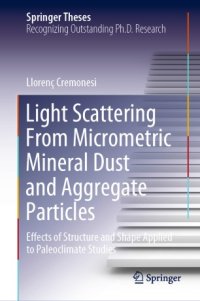
Ebook: Light Scattering From Micrometric Mineral Dust and Aggregate Particles: Effects of Structure and Shape Applied to Paleoclimate Studies
Author: Llorenç Cremonesi
- Tags: Physics, Optics Lasers Photonics Optical Devices, Ecology, Crystallography and Scattering Methods, Paleoecology
- Series: Springer Theses
- Year: 2020
- Publisher: Springer International Publishing
- Edition: 1st ed.
- Language: English
- pdf
Light scattering from particles in the nanometric and micrometric size range is relevant in several research fields, such as aerosol science and nanotechnology. In many applications, the description of the optical properties of non-spherical, inhomogeneous particles is still inadequate or requires demanding numerical calculations. Lorenz–Mie scattering and effective medium approximations represent currently the main theoretical tools to model such particles, but their effectiveness has been recently called into question.
This work examines how the morphology of a particle affects its scattering parameters from an experimental standpoint, supporting findings with extensive simulations. The dust content of Antarctic, Greenlandic, and Alpine ice cores is analysed with a particle-by-particle approach. Moreover, a study on colloidal aggregates shows that correlations among the fields radiated by primary particles are responsible for the poor agreement of effective medium approximations with experimental results. On the theoretical side, an interpretation in terms of the structure factor is given, which satisfactorily describes the data. The insights of this thesis are relevant for quantifying the contribution of mineral dust to the radiative energy balance of the Earth.